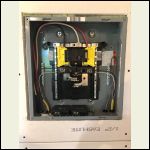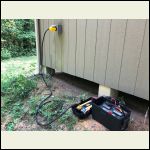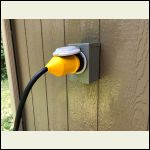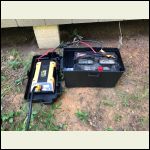Tim_Ohio
Member
|
# Posted: 3 Aug 2021 10:07am
Reply
Hello everyone,
I'm happy to say I've managed to install my inverter and battery set up for quiet mode at my cabin, while still maintaining the option of connecting a generator if needed for more power.
In the photos, you will see that I have a panel box set up in the cabin as a main service, not unlike an electrical set up for in your home. Outlets are in the walls every six feet throughout the cabin and one side each side is protected by a 20 amp breaker.
This is a little over-kill, but allows me to power it up
with a larger generator or a service from the utility company in the future. The earth ground is identical to your home service with two 8' rods, six feet apart.
Ground bars and neutral are set up to be separated or bonded, when needed.
In the photos, you will see that the outside receptacle is rated at 50 amp. The smallest breaker I could find for the main panel was 60, so I went with it.
For quiet mode, I made a connection chord with a 50 amp plug to the generator inlet box which then connected to a standard 15 amp plug into the inverter. For use with the battery only, the 50 amp plug has a jumper wire connecting the two 120 volt legs inside the plug. There was enough room inside to do it in the plug, instead in the panel box across the breakers. This way, I don't have to change anything, except to install the green bonding screw when I decide to use a 240 volt service from a generator. I do have to use a different chord dedicated to 240 volt from my generator, though.
When I operate on the battery power, I remove the green bonding screw in the panel to separate the
neutral and ground. I do this because when it was installed, I fried a 400 watt inverter. So, without any professional electrical experience, I'm now understanding that the inverter I was using did not like having the neutral and ground bonded. So, the screw gets removed and the neutral goes back to the inverter only, the ground goes to the earth ground set up for the cabin.
I've stayed over with it operating through the night. My cell phone was plugged into a cabin wall outlet and charged over night. Since I was powered up, I was able to get up and turn on a light whenever necessary as if I was on a main service at home.
The battery and inverter are small enough, I am able
to slide them under the cabin out of bad weather to
keep everything dry. The underside of the cabin is lined with metal tin and gives some fire safety protection.
I'm not sure how long the fully charged battery will operate. I've not stayed long enough to run out of power. I find using the automotive lead acid 12 volt battery convenient, since it's an old one changed out from my cars (which I do every 5 years anyway) My next test will be to see how long my ceiling fan will operate. Hopefully, I'll make it through the night with it on low.
If you have any comments on how it might be changed for the sake of safety, please let me know.
This was as low budget as I could come up with and
still maintain a safe set up. One thing I'd like to do is to replace the alligator clips with bolt on connections to the battery, but with some kind of receptacle off of the wire legs from the battery that would receive a plug of some kind from the inverter into each wire receptacle.
Tim_Ohio
Panel
| 
Wide view hook up
| 
Close up of plug
| 
Close up of battery and inverter
|
|
gcrank1
Member
|
# Posted: 3 Aug 2021 11:34am - Edited by: gcrank1
Reply
I get the 'wire like it is for line power' but until it is I think you have overcomplicated your current use.
It sounds like your elec power needs could be well met with just 120vac input as it is when you are on the bat and inv.
Fwiw, I made my input to the cabin similar to yours and my inside 'box' is 120 only, no 240 with 2 legs spitting.
When I run on the solar/bats/inv the cord from the inv is plugged into the cabin.
When I run on the gen the other is unplugged and the gen cord, at 120, is plugged in.
Quick, easy and foolproof.
Everything inside runs the same either way except on the gen is when we run the high-draw stuff like microwave, or toaster, or old 30cup elec perc 'can' as a water heater.
I suggest at least an inexpensive plastic storage box for your inverter, cut some wire holes up high. You can leave the inv in it with the lid off for ventilation/cooling and slide it under the cabin. For bad weather pop the lid on. If your draw is light clamps are fine. We run all the LED lights we want and fans vary from a cheap home ceiling fan to a 24ish" box fan to a small table fan, sometimes a couple at once. Ive found the fans hate msw inverters, psw is a must! The big 4 blade ceiling fan appears to draw about 2ish amps on med.
Btw, we are doing this with a little 300w psw unit, NO trips yet in about a year of use. Its idle draw is so low I dont see a change on my battery leaving it on all night.
Larger inv's/oversized for the devices run on them can have a rather large bite out of available AHs, especially if the bat isnt being recharged.
And with you using an older 'starting' battery I wouldnt draw it down regularly past 25% IF I cared about making it last (you may not); I used to rotate bats in a similar use. Id bring a freshly charged one on each visit, use the old one until the lights got too dim (battery abuse! lol) and hook in the replacement. They lasted for years more than many said they would.
|

